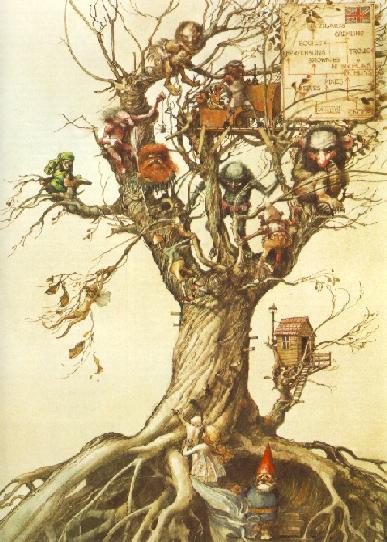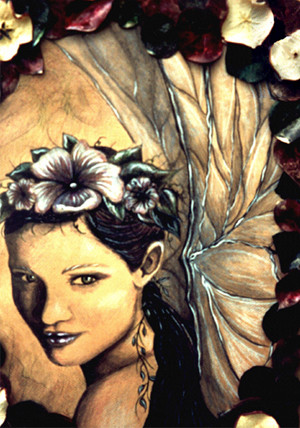Tir Nan Og (The Land of the Young)
Tir Nan Og is the land to which the Irish faeries know as Tuatha de Danann
(Too-ah day Thay-nan, or Tootha day danan) flead when their lands were
taken by the Milesians. In Tir Nan Og they spend their days feasting, gaming,
love-making and partaking of beautiful music. The faeries can even enjoy
the thril of battle, for anyone slain is resurected the following day.
It is the paradise that mortals can only dream of.
Faeries, also known as the little people, green men, good folk,
fayerye, fairye, fayre, faery, fairy, fatae (Latin), fee (French) and fay
(Anglican), are one of the most popularized fanciful races in mythology
and literature. They are featured in myths from the early Norse-men, Celts,
Romans as well as in Medieval French, English, Irish and Scottish tales.
In literature faeries have been written about by Chaucer and Shakesphere
and many others. But what are faeries, and do they have fairy tales? This
page attempts to unlock just a few of the mysteries surrounding the little
folk.
A note about grammer
More about the great THREAT to Tir Na Nog

The above jpg was scanned from The Encyclopedia of Things That Never
Were Written by Michael Page, and illustrated by Robert Ingpen.
Much of the below information was found in English Myths & Legends
by Henry Bett, Faeries by Brian Frond and Alan Lee, and The Encyclopedia
of Things which Never Were by Michael Page.
The Faeries:
These are the creatures and organizations which belong to the realm
of faerie, in the most narrow definition of the term. Most of these creatures
and myths are of celtic, gaelic and scottish origin.
Goblins
Faerie Organizations
Unsellie Court
Bendith Y Mamau
Tricksters
Helpful Spirits
Leanan Sidhe
The Not-Faeries:
In addition to those creatures described above, there are a number
of creatures and terms which have come to be used almost interchangeable
with the term faerie over the centuries. They are however of different
origns and were originally intended to describe different, although similar
creatures.
Elves
Pixies
Gnomes
Dwarves
The story of Oisin The first mortal to
visit Tir Nan Og.
Irish Invasion Cycle
Faerie Ways and Activities:
Insight into just a few of the mysteries surrounding faeries.
Origins
Iron
Glaymor
Aging
Religion
Names
Dates
Dwellings
Non-Celtic Faeries:
Although the term Faerie specifically referrs to the spirits and creatures
of Celtic origin, there are many similar creatures from other cultures
and myth collections from every corner of the world.
African: Abatwa
Austrailian: Mimis, Yowie
Baltic: Leshy, Nixie, Zaltys
Greek: Faun, Nereid, Nymph, Satyr
Indian: Naga
North American: Bokwus, Manitou, Nagumwasuck,
Ohdow, Kushtaka
Pacific Islands: Menahune
Russian: Domovoi, Rusalki, Vodyanoi
South American: Dama Dagenda, Kilyakai
Sweeden: Uldra
Outer Space: ?!?
A Dark view of the future, of both men and fae
Counter Charm
Images below are courtesy of Jessica
Galbreth

 And ance it fell upon a day,
A cauld day and a snell
When we were frae the hunting come,
That frae my horse I fell;
The Queen o' Faeries she caught me,
In yon greeen hill to dwell.
And pleasant is the fairly land,
But, an eerie tale to tell,
Aye at the end of seven years
We pay a tiend to hell;
I am sae fair and fu' o' flesh
I'm fear'd it be mysel!
from Tamlane
And ance it fell upon a day,
A cauld day and a snell
When we were frae the hunting come,
That frae my horse I fell;
The Queen o' Faeries she caught me,
In yon greeen hill to dwell.
And pleasant is the fairly land,
But, an eerie tale to tell,
Aye at the end of seven years
We pay a tiend to hell;
I am sae fair and fu' o' flesh
I'm fear'd it be mysel!
from Tamlane
A story about my personal favorite book on Celtic
faeries, Faeries by Bria Froud and Alan Lee, sent to me by Mark.
Graphics used in this site as well additional
faerie pictures.
Other sites with Faeries
Awards and web rings
If you have any comments, suggestions or submissions, I would love
to hear them.
Mail Me
This page was last modified on 4/9/02



